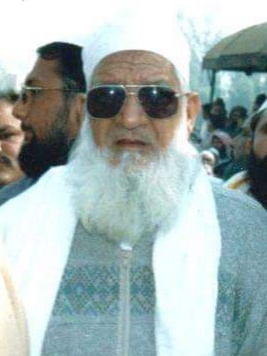Top Qs
Timeline
Chat
Perspective
Sayed Nafees al-Hussaini
Pakistani Islamic scholar and Calligrapher (1933–2008) From Wikipedia, the free encyclopedia
Remove ads
Sayed Nafees al-Hussaini (11 March 1933 – 5 February 2008) (Urdu: سید نفیس الحسینی) was a calligrapher, Islamic scholar, poet, and spiritual figure. He was also blessed with calligraphy at one of the doors of the Masjid Al Haram in Makkah.[1]
Remove ads
Early life and education
Sayed Nafees Al-Husseini was born in 1933 in Sialkot.[citation needed] His real name was Sayed Anwar Hussain but he became known as Nafees Al-Husseini Shah in the Islamic world.[citation needed] He received his early education at a high school in Bhopalwala. In 1947, he came to Faisalabad and studied up to FA.[1]
Career
Nafees al-Hussaini started his calligraphy career in 1948. He inherited the art of calligraphy from his father, Sayed Muhammad Ashraf Ali, who was an expert in Naskh and had a reputation for expertise and calligraphy in the Holy Qur'an. In 1952 he set up his office in Lahore. He gained special place and expertise in Naskh and Nastaliq scripts, apart from this he also created works of art in Kufic, Thuluth, Ruqʿah script and Ijaza. Nafees Al-Husseini visited many countries and participated in the International Calligraphy Competition in Iran and Egypt as a judge.[1][2] He also invented a script in Nastaliq called "Nafees Nastaliq".[3]
He also served as Central Deputy Emir of Aalmi Majlis Tahaffuz Khatm-e-Nubuwwat.[4]
Remove ads
Awards
- Pride of Performance (1985)[5]
- Sitara-i-Imtiaz[5]
- First prize in a calligraphy exhibition of the Pakistan National Council of the Arts in 1980.[4]
- First prize in the All Pakistan exhibition of Quranic calligraphy in 1982 organized by the Pakistan Public Relations Society.[4]
Death
He died in Lahore on 5 February 2008. Funeral prayers were offered at Badshahi Masjid Lahore in which more than one lakh people from all over the country participated. And according to his will, he was buried in the graveyard of Khanqah Syed Ahmed Shaheed.[1]
Writings
Summarize
Perspective
Syed Nafees al-Hussaini authored several works in the fields of Islamic mysticism, poetry, and devotional arts. His works include both poetic and prose contributions, many of which are preserved and published through private collections and cultural institutions.
- برگِ گل (Barg-e-Gul, "Petal of a Flower") – Published in 2006, this Urdu poetry collection includes devotional and spiritual verses (naat, manqabat, and Sufi reflections). It illustrates his command of classical poetic meters and themes of divine love.[6]
- رسالہ اشغال (Risāla-e-Ashghāl, "Treatise on Spiritual Exercises") – A concise handbook written in 1978, focusing on various spiritual practices (ashghāl) rooted in Sufi traditions. It includes litanies, invocations, and contemplative exercises used in the Qadiriyya and Naqshbandiyya orders.[7]
- کلامِ حضرت سید نفیس الحسینی (Kalām-e-Hazrat Syed Nafees al-Hussaini, "Poetry of Syed Nafees al-Hussaini") – A posthumous collection of his Urdu poetry and couplets, published online in 2014. This volume gathers his unpublished works, including devotional poetry, ghazals, and reflections on Islamic ethics. [8]
- نستعلیق نامہ (Nastaliq Nāmah, "The Book of Nastaliq") – A collection of his calligraphic art compiled alongside instructional notes on the aesthetics and history of the Nastaliq script. Though not a literary work in the traditional sense, this manuscript represents his artistic legacy and was shared with students and disciples.[9]
Several of his unpublished works remain preserved by his family and followers and may appear in future collections. His literary and artistic contributions are also featured in cultural exhibitions and are available through the online platform Nafees Library.
Remove ads
See more
References
Wikiwand - on
Seamless Wikipedia browsing. On steroids.
Remove ads

